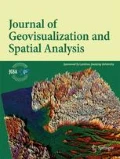Abstract
With the advent of location-based services, the demand for location data has dramatically increased. Geocoded locations have become necessary in many GIS analysis, cartography, and decision-making workflows. A reliable geocoding system that can effectively return any location on earth with sufficient accuracy is desired. This study is motivated by a need for a geocoding system to support university campus applications. Address-based geocoding systems have been used for decades. However, they present limitations in address resources, address standardization, and address database maintenance. These limitations have recently sparked an interest in developing alternative geocoding systems that apply alphanumeric codes as a reference to locations, such as Geohash, Google’s Open Location Code, and what3words to name a few. Comparing to other geocoders, what3words (w3w) has many advantages. It uses a simple format of code consisting of three words, it is less error-prone, codes are easier to memorize, and multiple languages are supported. However, its fixed resolution (consisting of 3 m by 3 m square cells) and lack of consideration of the third dimension may limit its applicability. To better support geographic applications with special requirements, the w3w geocoding system needs to be extended. This paper proposes extensions of w3w in two aspects: variable resolution and third dimension support. A geocoding processing tool that implements these extensions is being developed to support the need of a university campus’ facility management, emergency evacuation and route navigation planning, student survey data management, and other location-based services.




















Similar content being viewed by others
References
Barr R (2015) About what3words. Retrieved from what3words.com: https://what3words.com/about/ [visited on October 31, 2017]
Chen D, Cheng C, Tong X, Yuan J (2016) Research on the multi-scale spatial location coding model for address. Geogr Inf Sci 18(6):727–733. https://doi.org/10.3724/SP.J.1047.2016.00727
Geelen P (2015) Mapcode downloads and developer resources. Retrieved from mapcode.com: http://www.mapcode.com/downloads.html?iso3=112&mapcode=49.4V [Visited on October 31, 2017]
Geohash (2017) Tips & trick—geohash.org. Retrieved from geohash.org: geohash.org/site/tips.html [Visited on October 31, 2017]
Goldberg DW (2011) Advances in geocoding research and practice. Trans GIS 15(6):727–733. https://doi.org/10.1111/j.1467-9671.2011.01298.x
Goldberg D, Wilson J, Knoblock C (2007) From text to geographic coordinates: The current state of geocoding. URISA Journal 19(1):33–46
Karimi HA, Sharker MH, Roongpiboonsopit D (2011) Geocoding recommender: an algorithm to recommend optimal online geocoding services for applications. Trans GIS 15(6):869–886. https://doi.org/10.1111/j.1467-9671.2011.01293.x
Kellison MT (2012) Address points and a master address file: improving efficiency in the City of Chino. Master dissertation. Los Angeles, California, USA: University of Southern California
Lee J (2009) GIS-based geocoding methods for area-based addresses and 3D addresses in urban areas. Environ Plan B Plan Des 36(1):86–106. https://doi.org/10.1068/b31169
Pozyx (2017) Pozyx accurate positioning. Retrieved from https://www.pozyx.io/ [Visited on October 31, 2017]
Rhind G (2015) How Google could improve open location code. Retrieved from pcapredict.com: http://resources.pcapredict.com/index.php/google-open-location-codes/#comment-3294363901 [Visited on October 31, 2017]
Stefanakis E (2016) Location encoding systems—could geographic coordinates be replaced and at what cost? GoGeomatics Magazine. Retrieved from https://gogeomatics.ca/location-encoding-systems-could-geographic-coordinates-be-replaced-and-at-what-cost/ [Visited on October 31, 2017]
Teunissen P, Montenbruck O (Eds) (2017) Springer handbook of global navigation satellite systems (Springer Handbooks) 1st edn. Springer, Cham, p 1327
The Ethicalist (2017) How three words are making the world a safer place. Social Business. Retrieved from https://theethicalist.com/three-words-making-world-safer-place/ [Visited on October 31, 2017]
Verbree E, Zlatanova S (2007) Positioning LBS to the third dimension. In: Cartwright W, Gartner G, Meng L (eds) Location based services and telecartography. Springer, Berlin, pp 107–118. https://doi.org/10.1007/978-3-540-36728-4_8
w3w API (2017). what3words restful API. Retrieved from https://docs.what3words.com/api/v2/ [Visited on October 31, 2017]
Zandbergen PA (2008) A comparison of address point, parcel and street geocoding techniques. Comput Environ Urban Syst 32(2008):214–232. https://doi.org/10.1016/j.compenvurbsys.2007.11.006
Acknowledgments
The authors wish to thank the editors and anonymous reviewers for their valuable comments on the initial manuscript.
Funding
This work was funded by the Natural Sciences and Engineering Research Council of Canada (NSERC-DG).
Author information
Authors and Affiliations
Corresponding author
Ethics declarations
The manuscript is compliant with ethical standards.
Conflict of Interest
The authors declare that they have no conflict of interest.
Ethical Approval
Not needed.
Informed Consent
Not needed.
Rights and permissions
About this article
Cite this article
Jiang, W., Stefanakis, E. What3Words Geocoding Extensions. J geovis spat anal 2, 7 (2018). https://doi.org/10.1007/s41651-018-0014-x
Published:
DOI: https://doi.org/10.1007/s41651-018-0014-x




